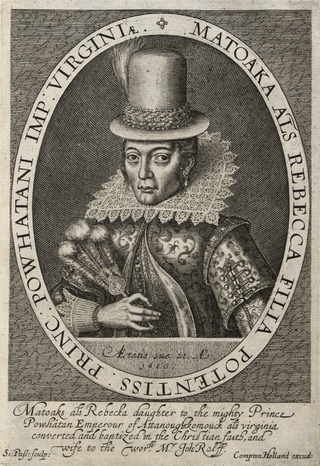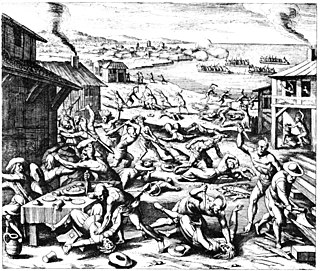Related Research Articles

The Jamestown settlement in the Colony of Virginia was the first permanent English settlement in the Americas. It was located on the northeast bank of the James River, about 2.5 mi (4 km) southwest of the center of modern Williamsburg. It was established by the Virginia Company of London as "James Fort" on May 4, 1607 O.S., and was considered permanent after a brief abandonment in 1610. It followed several failed attempts, including the Lost Colony of Roanoke, established in 1585 on Roanoke Island, later part of North Carolina. Jamestown served as the colonial capital from 1616 until 1699. Despite the dispatch of more settlers and supplies, more than 80 percent of the colonists died in 1609–1610, mostly from starvation and disease. In mid-1610, the survivors abandoned Jamestown, though they returned after meeting a resupply convoy in the James River.

John Smith was an English soldier, explorer, colonial governor, admiral of New England, and author. He played an important role in the establishment of the colony at Jamestown, Virginia, the first permanent English settlement in North America, in the early 17th century. He was a leader of the Virginia Colony between September 1608 and August 1609, and he led an exploration along the rivers of Virginia and the Chesapeake Bay, during which he became the first English explorer to map the Chesapeake Bay area. Later, he explored and mapped the coast of New England. He was knighted for his services to Sigismund Báthory, Prince of Transylvania, and his friend Mózes Székely.

Pocahontas was a Native American woman belonging to the Powhatan people, notable for her association with the colonial settlement at Jamestown, Virginia. She was the daughter of Powhatan, the paramount chief of a network of tributary tribes in the Tsenacommacah, encompassing the Tidewater region of what is today the U.S. state of Virginia.

Edith Wilson was the first lady of the United States from 1915 to 1921 and the second wife of President Woodrow Wilson. She married the widower Wilson in December 1915, during his first term as president. Edith Wilson played an influential role in President Wilson's administration following the severe stroke he suffered in October 1919. For the remainder of her husband's presidency, she managed the office of the president, a role she later described as a "stewardship", and determined which communications and matters of state were important enough to bring to the attention of the bedridden president.

The Powhatan people (;) are Native Americans who belong to member tribes of the Powhatan Confederacy, or Tsenacommacah. They are Algonquian peoples whose historic territories were in eastern Virginia.

Opechancanough was paramount chief of the Powhatan Confederacy in present-day Virginia from 1618 until his death. He had been a leader in the confederacy formed by his older brother Powhatan, from whom he inherited the paramountcy.

Powhatan, whose proper name was Wahunsenacawh, was the leader of the Powhatan, an alliance of Algonquian-speaking Native Americans living in Tsenacommacah, in the Tidewater region of Virginia at the time when English settlers landed at Jamestown in 1607.

Weroance is an Algonquian word meaning leader or commander among the Powhatan confederacy of the Virginia coast and Chesapeake Bay region. Weroances were under a paramount chief called Powhatan. The Powhatan Confederacy, encountered by the colonists of Jamestown and adjacent area of the Virginia Colony beginning in 1607, spoke an Algonquian language. Each tribe of the Powhatan Confederacy was led by its own weroance. Most foreign writers who have come across a weroance only did so on a special occasion. This is the case because a foreigner's presence was special. John Smith noted that there are few differences between weroances and their subjects.

The Indian massacre of 1622 took place in the English colony of Virginia on 1 April [O.S. 22 March] 1622. English explorer John Smith, though he was not an eyewitness, wrote in his History of Virginia that warriors of the Powhatan "came unarmed into our houses with deer, turkeys, fish, fruits, and other provisions to sell us"; they then grabbed any tools or weapons available and killed all English settlers they found, including men, women, and children of all ages. Opechancanough, chief of the Powhatan Confederacy, led a coordinated series of surprise attacks that ended up killing a total of 347 people — a quarter of the population of the Colony of Virginia.
The Machapunga were a small Algonquian language–speaking Native American tribe from coastal northeastern North Carolina. They were part of the Secotan people. They were a group from the Powhatan Confederacy who migrated from present-day Virginia.

The Anglo–Powhatan Wars were three wars fought between settlers of the Colony of Virginia and the Powhatan People of Tsenacommacah in the early 17th century. The first war started in 1609 and ended in a peace settlement in 1614. The second war lasted from 1622 to 1632. The third war lasted from 1644 until 1646 and ended when Opechancanough was captured and killed. That war resulted in a defined boundary between the Indians and colonial lands that could only be crossed for official business with a special pass. This situation lasted until 1677 and the Treaty of Middle Plantation which established Indian reservations following Bacon's Rebellion.
The Patawomeck are a Native American tribe based in Stafford County, Virginia, along the Potomac River. Patawomeck is another spelling of Potomac.
Henry Spelman (1595–1623) was an English adventurer, soldier, and author, the son of Erasmus Spelman and nephew to Sir Henry Spelman of Congham (1562–1641). The younger Henry Spelman was born in 1595 and left his home in Norfolk, England at age 14 to sail to Virginia Colony aboard the ship Unity, as a part of the Third Supply to the Jamestown Colony in 1609. He is remembered for being an early interpreter for the people of Jamestown as well as writing the Relation of Virginia, documenting the first permanent English colonial settlement in North America at Jamestown, Virginia, and particularly the lifestyles of the Native Americans of the Powhatan Confederacy led by Chief Powhatan.

Carolina Algonquian was an Algonquian language of the Eastern Algonquian subgroup formerly spoken in North Carolina, United States.

The Secotans were one of several groups of Native Americans dominant in the Carolina sound region, between 1584 and 1590, with which English colonists had varying degrees of contact. Secotan villages included the Secotan, Aquascogoc, Dasamongueponke, Pomeiock (Pamlico) and Roanoac. Other local groups included the Chowanoke, Weapemeoc, Chesapeake, Ponouike, Neusiok, and Mangoak (Tuscarora), and all resided along the banks of the Albemarle and Pamlico sounds. They spoke Carolina Algonquian language, an Eastern Algonquian language.
Karen Ordahl Kupperman is an American historian who specializes in colonial history in the Atlantic world of the sixteenth and seventeenth centuries.

Opossunoquonuske was a Weroansqua of an Appomattoc town near the mouth of the Appomattox River. Weroansqua is an Algonquian word meaning leader or commander among the Powhatan confederacy of Virginia coast and Chesapeake Bay region. She was known as the queen of Appamatuck, The community she led was large enough to provide an estimated twenty warriors to the Powhatan Confederacy.

A Lovelock was popular amongst European "men of fashion" from the end of the 16th century until well into the 17th century. The lovelock was a long lock of hair, often plaited (braided) and made to rest over the left shoulder to show devotion to a loved one.
Tackonekintaco was a 16th and 17th-century leader of the Warraskoyack tribe of the Powhatan Confederacy, in what is now the U.S. state of Virginia.
Michael Sicklemore was an English gentleman, soldier and explorer. He was a colonist with the Jamestown first supply and led an unsuccessful expedition to find traces of Walter Raleigh's lost Roanoke Colony.
References
- 1 2 3 Price, David A. (2007-12-18). Love and Hate in Jamestown: John Smith, Pocahontas, and the Start of a New Nation. Knopf Doubleday Publishing Group. ISBN 978-0-307-42670-3.
- 1 2 "JR1225B | Historic Jamestowne" . Retrieved 2024-05-09.
- ↑ Kay, Alan N. (1992). Jamestown Journey. Thomas Publications. ISBN 978-0-939631-53-7.
- ↑ Billings, Warren M. (2008). The Old Dominion in the Seventeenth Century (Volume 1 of 2) (EasyRead Large Bold Edition). ReadHowYouWant.com. ISBN 978-1-4429-6084-8.
- ↑ "Kids in Jamestown History | Historic Jamestowne" . Retrieved 2024-05-09.
- 1 2 Kupperman, Karen Ordahl (2021-01-19). Pocahontas and the English Boys: Caught between Cultures in Early Virginia. NYU Press. ISBN 978-1-4798-0598-3.
- ↑ Society, Hakluyt (1906). Works Issued by the Hakluyt Society: Extra series.
- ↑ Egloff, Nancy. "'Trusty Servants' and 'Converted Infidells': Cultural Intermediaries In Early Virginia". Jamestown-Yorktown Foundation.
- ↑ Simms, William Gilmore (1846). The Life of Captain John Smith: The Founder of Virginia. G.F. Cooledge & Brother.
- ↑ Kupperman, Karen Ordahl (2000). Indians and English: Facing Off in Early America. Cornell University Press. ISBN 978-0-8014-8282-3.
- ↑ Goode, George Brown (1887). Virginia Cousins: A Study of the Ancestry and Posterity of John Goode of Whitby, a Virginia Colonist of the Seventeenth Century, with Notes Upon Related Families, a Key to Southern Genealogy and a History of the English Surname Gode, Goad, Goode Or Good from 1148 to 1887. J. W. Randolph & English.
- ↑ "The First Residents of Jamestown - Historic Jamestowne Part of Colonial National Historical Park (U.S. National Park Service)". www.nps.gov. Retrieved 2024-05-09.
- ↑ Gray, Edward G.; Fiering, Norman (2000). The Language Encounter in the Americas, 1492-1800: A Collection of Essays. Berghahn Books. ISBN 978-1-57181-160-8.
- ↑ Kupperman, Karen Ordahl (2007-03-23). The Jamestown Project. Harvard University Press. ISBN 978-0-674-02474-8.
- ↑ "Surviving Jamestown | Historic Jamestowne" . Retrieved 2024-05-09.
- ↑ "Audiobook: Surviving Jamestown the Adventures of young Sam Collier". portal.learningally.org. Retrieved 2024-05-09.
- ↑ Massie, Elizabeth (2000-03-15). 1609: Winter of the Dead: A Novel of the Founding of Jamestown. Macmillan. ISBN 978-0-8125-9093-7.
- ↑ "Sam Collier And The Founding Of Jamestown | Historic Jamestowne" . Retrieved 2024-05-09.
- ↑ "Sangre en el Rio | Historic Jamestowne" . Retrieved 2024-05-09.
- ↑ Walker, Sally M. (2009). Written in Bone: Buried Lives of Jamestown and Colonial Maryland. Carolrhoda Books. ISBN 978-0-8225-7135-3.
- ↑ "Blood on the River | Historic Jamestowne" . Retrieved 2024-05-09.